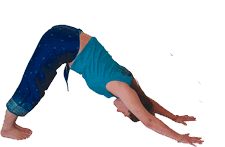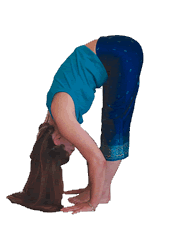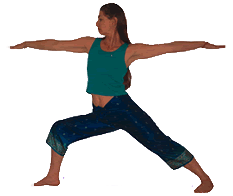BENEFITS OF YOGA
The physical benefits of yoga are strength, tone, suppleness and flexibility of the entire muscular system, stimulation of the glands which control hormone production, increased blood flow together with improved circulation and excellent breath control. The internal organs are also massaged during yoga practice.
However, along with these comes an increase in self confidence, excellent balance and a general feeling of well being and health, as well as a positive outlook on life. Yoga will also put one intuitively in touch with the needs of one’s body.Yoga can also help to allay sleeping problems and insomnia.
One of the basic tenets of yoga is self observation. This puts you instinctively in touch with your body and emotions.
BASIC GUIDELINES TO THE PRACTICE OF YOGA
Initially you might experience a little stiffness or awkwardness while doing the postures but with practice this feeling should disappear. The different postures will show which parts of the body are stronger or weaker than other parts and the weaknesses can gradually be worked on and reduced. There should be no straining, forcing, struggling or pain during yoga practice. There should rather be a sense of extending, flowing and graceful stretching into each pose. Once the maximum stretch has been attained you should be able to relax into the posture and hold it for a comfortable period of time. If any difficulty is experienced in attaining a posture try using a chair or the wall to carry and balance the bulk of your weight.
Listen to your body. The two main aspects of all yoga postures are steadiness and comfort. Find your comfort zone in the pose and relax into it. Do not overextend the muscles. Yoga practice should be pleasurable and comfortable. Sometimes conflict arises between the mind and the body. The mind wishes to do more and forgets that the body is not yet ready. If you work your body too hard it will take its revenge by being stiff the next day. Try not to let your mind wonder during yoga practice. Focus your attention on the breath and on what the body is doing and how it feels.
Yoga can be practised during pregnancy with adaptations to the postures to suit each individual’s needs. These will vary from person to person so it is necessary to be in tune with your body and to note any discomfort which may arise and alter the positions to suit yourself. You do not have to look like the model in the photographs. How you look during yoga practice is not of major import. What counts is how you feel.
Do not practice yoga with a full stomach. Allow four hours after a heavy meal and two hours after a light meal before attempting yoga postures. Ensure that the bowel and bladder have been emptied.

A static posture is a posture in which the body is held still and continues to breathe comfortably eg. The Downward Facing Dog Stretch (Adho Mukha Svanasana). A dynamic posture is a posture in which the body moves eg. Cat Stretch.
Most of the classical yoga postures work a certain part of the body quite intensively. It is therefore necessary to do a counter posture afterwards. An example of this would be the Shoulder Stand (Sarvangasana). This pose closes the muscles of the throat and balances the thyroid and parathyroid glands. After practising this posture it is necessary to do something that will open the throat area and allow oxygenated blood to wash over the glands.
Always work both sides of the body evenly. What you do with one side of the body you must always do with the other side of the body. You will find that one side of the body is always stronger and more flexible than the other side. This is normal.

Almost everything in yoga works to assist and enhance the natural functions of the body. Always work the right side of the body and then the left side, as this aids the peristaltic movement of digestion.
Put on some gentle background music to accompany your yoga session.
Always finish your yoga session with a period if relaxation in the Pose of the Corpse Savasana.
WHERE TO PRACTICE
Yoga should be done in a light and well ventilated room. The room should be quiet and clean. Fresh air is essential. Air conditioning is not recommended as it changes the electrical charge of the oxygen we breathe. This makes it difficult for the body to absorb it. Negatively charged oxygen is more beneficial to the body. This is probably why we feel invigorated after a lightning storm. There should be enough space for you to stretch out and move with ease. If the weather is pleasant do your yoga practise outside. Wear as little clothing as decency and the weather permit. All clothing should be loose and comfortable. Perform your postures in bare feet. If the weather is cold wear socks. Special, sticky yoga mats are available but are not essential. A large bath towel or small mat will suffice. When practising at home choose a time when there will be no interruptions. Remember to turn on the answering machine or take the phone off of the hook. The body is less supple in the morning than in the evening. A warm shower can loosen the muscles and joints before a morning yoga session. Bolsters or pillows and a chair can be used for support in the more difficult postures. Ensure that these items are laid out before starting the session.
CAUTIONS

- It is important to relax between postures to allow the heart rate and the breathing to return to normal.
- Do not do folded leg postures if suffering from varicose veins or venous blood clots.
- Use the wall or a chair to support extra weight if necessary.
- When bending forward, stretch out from the hips. Do not curve the spine.
- Do not clench your teeth while practising your postures.
- Do not force your body to work to the point that it shakes or vibrates. If this occurs try to relax into the posture or come out of it altogether.
- One of the basic ethics of yoga is non violence. This includes being gentle with your own body.
- Never do a spinal twist after a backward bend or a backward bend after a spinal twist. The backward bends open the spine and there is a chance that you could pop a disc if you then twist the spine.
- If pain is experienced during any posture desist from practising it and discuss it with your teacher. You might be making a basic error which she will be able to correct.

 Return to menu
Return to menu